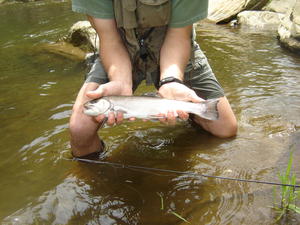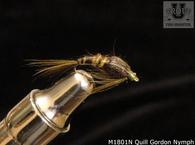
It takes a special eye trained to observe the trout in the streams. Sometimes the water is stained; sometimes it is the rapids, sometimes down deep but always a challenge. For many anglers seeing trout even in the clearest of water is a hard thing to do. By the time they see the trout; the fish see you and they are headed for “Dixie” as I am prone to say. Your opportunity to cast to an unknowing relaxed trout is gone. So what do we do to educate and calibrate our eyes?
The first thing you need is a good set of polarized glasses. Do not waste your money on the cheapest garden variety of sun glasses especially if not polarized. Sighting the trout is too important to leave to the cheaper glasses. Be prepared to spend some serious money perhaps from $50 to $100 and watch for the sales by Orvis or other dealers. Any good quality lens maker will do, they need not be designer glasses in the $200 and over category.
However, the lens shade is as important as the manufacturer of the lens, so shade is a topic of concern when purchasing your shades. Smith has come out with "polar chromatic" lenses that change color depending on the light conditions. While these are very helpful, not everyone is willing to put down $200 on a pair of shades. Copper or brown lenses tend to be the most versatile and illuminate the fish the best. Gray or mirror lenses are best used on clear sky days, white sand bottoms, and are thus best used in saltwater applications.
Once you have your fancy glasses picked out, you must learn how to distinguish fish from the river bottom. Instead of looking for a whole fish in water, look for moving fish parts, such as a white mouth opening, a fin swaying, or tail movement, or simply the shadow of the fish on the river bottom. Also, look for different coloration as some of the trout will appear very different than the bottom whether it is gravel, or hard substrate. You will soon learn to recognize the color variations of the brookies, the rainbow and the browns. It is also helpful to look for the pectoral fins, as these are often lighter in color than the rest of the fish, and constantly move.
Once you locate your targeted trout, keep your eyes on the trout until you figure out exactly what that trout is doing, be patient and don't cast right away! Figure out the feeding pattern is he hitting the surface or just under the surface or is he eating the bottom midges, emergers or nymphs? Then determine your casting lane and your drift angle before you even think about slinging line to the old lunker.
the feeding pattern is he hitting the surface or just under the surface or is he eating the bottom midges, emergers or nymphs? Then determine your casting lane and your drift angle before you even think about slinging line to the old lunker.
Once your fly is in front of the fish, see how the fish reacts to your fly. If he is spooked by the fly, immediately change bugs, usually going more natural and smaller is your best bet. Not many things are better in the world of fly fishing than sight fishing to big trout and watching him as he hits your fly. Hopefully these tips will help you see more trout.





